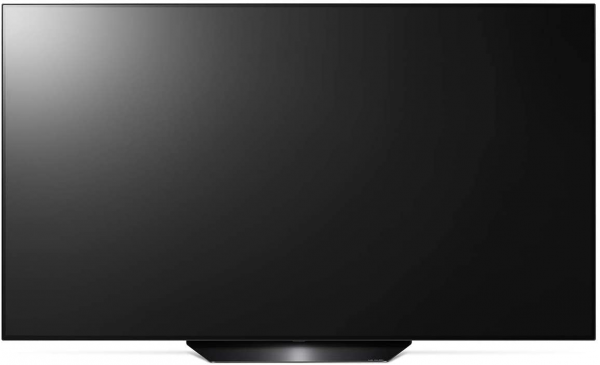LG
65B9 TV: LG's most affordable Oled TV
Aprox. 1999€
See specificationsThe LG B9 is simply the most affordable Oled TV from the Korean manufacturer in the 2019/2020 range and it is now very affordable. Let's see if it compares with the LG C9 and E9 ...
Positive points
Image quality.
Excellent colorimetry in HDR Cinema mode.
Faithful HDR processing.
Infinite contrast.
Viewing angles.
Responsiveness of Oled technology.
Excellent delay on display.
HDMI 2.1 compatibility (VRR, ALLM, eARC).
G-Sync compatibility.
Consumption down compared to B8.
Bad points
Non-backlit remote control.
Brightness peak in HDR mode lower than other Oled models and better LCDs.
Our review
Presentation
It took a while before we could get our hands on the Oled B9 TV, the cheapest model in the LG range. This 65B9 embeds a 10-inch 65-inch OLED panel (≈165 cm) displaying an Ultra HD definition of 3 840 x 2 160 px. If the structure of the sub-pixels is slightly different from that of the Oled TVs released since the summer of 2018, it is identical to that of the other Oled TVs released in 2019. The manufacturer always announces a maximum brightness around 750 cd / m² , a 99% coverage of the DCI-P3 color space, infinite contrast and zero remanence time. The second generation α7 (Alpha 7) processor is a slight evolution from the previous year's α7 and remains slightly lower than the C9's α9.
The LG Oled 65B9 is sold for around € 2,000, which is € 500 less than the LG 65C9. It is also available in 55 versions (≈140 cm / 55B9) for around € 1,200, but it can sometimes be found at € 1,100, making it one of the most affordable Oled TVs on the market.
All the brightness and colorimetric measurements mentioned in this article were carried out with a SpectraCal C6-HDR probe and the CalMAN Ultimate software.
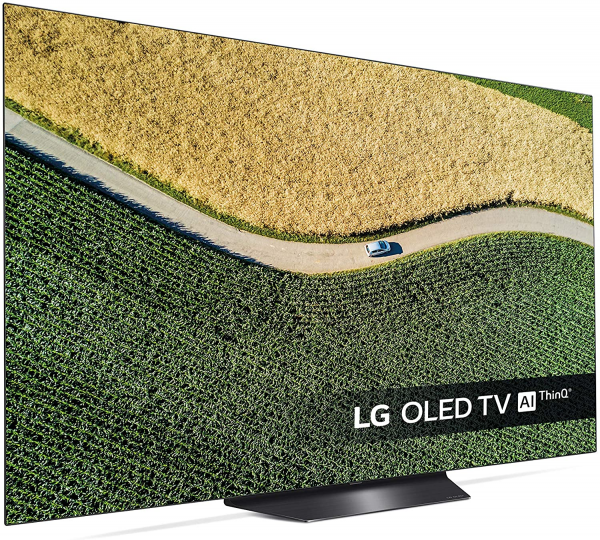
Image quality
The LG 65B9 has an Oled panel that always uses four sub-pixels (white, blue, red and green). The structure is very slightly different from that observed on the LG 65C9, but the red sub-pixel is always larger in order to support a higher brightness peak while maintaining a color temperature close to the 6,500 K reference in video. LG Display - the manufacturer of Oled panels for all TV manufacturers - often makes small adjustments during the year to optimize the size of the sub-pixels and find the right balance between maximum brightness and lifespan. Oled technology always offers the best viewing angles since the loss of brightness at 45 ° is limited to 24%. There is also no variation on black, the sub-pixels being extinguished individually.
Cinema mode offers an image close to perfection on LG TVs. With the exception of yellow, all the colors tested display a delta E of less than 3, a threshold below which the human eye no longer perceives a difference between the colors displayed on the screen and the colors expected. The average delta E is 1.8, which is excellent; colors can therefore be considered as perfectly faithful to those sent by the source.
The average gamma measured at 2.42 is very close to the reference value. There is a variation on the lighter grays, but without influence on the overall rendering. Like the 2017 and 2018 models, this television now has an automatic gamma mode (much simpler for the general public) which automatically switches from gamma 2.2, ideal for HD / Full HD content, to gamma 2.4 which is the standard for Ultra HD Blu- ray.
What to say about the color temperature ... just perfect. The curve is stable over the entire spectrum and the average is 6,500 K, the reference value in video.
It is no longer a surprise, the contrast obtained by an Oled panel is considered to be infinite. Indeed, even with a white calibrated at 152 cd / m², black is measured at 0 cd / m² (our probe cannot measure a black below 0.0049 cd / m²). This contrast is still as impressive and allows you to enjoy all the nuances, even in complete darkness.
In cinema mode, scaling is always very gentle, with an absence of artifacts and respect for the source. In standard mode, scaling is a little more aggressive, but without improving the details excessively. The α7 (Alpha 7) Gen 2 processor is less perforating than the C9's α9 Gen2 in image processing, especially in reducing banding and managing very dark grays. These cases are very specific and the difference in daily use is very small; this can still justify the move to the upper range for lovers of beautiful images. The good surprise comes from the motion compensation engine, which is very efficient from this model. There is very little difference with C9, E9 and W9 TVs equipped with the more powerful processor from LG. The TruMotion can still be controlled by hand by managing the saccade (De-Judder) for 24/25/30 Hz content and the blurred zones (De-Blur) for 50/60 Hz content. It also offers a system of insertion of black images to deceive retinal persistence (Motion OLED) which logically reduces the brightness of the screen, but also introduces a flickering phenomenon that is not necessarily pleasant.
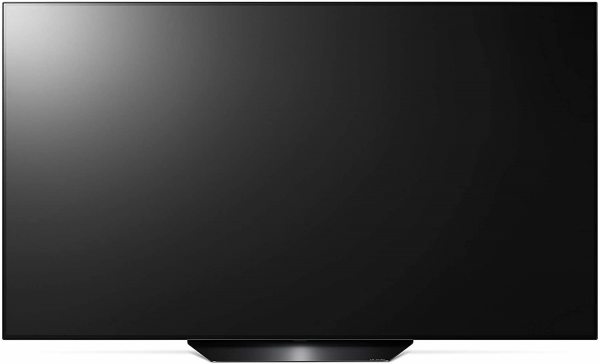
HDR
The LG 65B9 is compatible with HDR10, HLG (Hybrid Log Gamma) and Dolby Vision signals, but it does not support HDR10 +, a format competing with Dolby Vision.
With a maximum HDR signal of 10,000 cd / m², the Display Tone Mapping perfectly follows the EOTF curve up to 60% brightness. Subsequently, the television begins to gradually smooth the curve in order to avoid clipping as much as possible. The weak point of Oled technology remains the maximum brightness, which we measured at only 652 cd / m² on our 65B9, which is 70 cd / m² less than the LG 65C9. As always, the Oled remains quite far from the best VA type LCD TVs which greatly exceed 1000 cd / m², such as the Sony 65ZF9 and its 1,940 cd / m² or the Samsung 75Q900R (8K) flashed at 2,280 cd / m². It is this limited light peak that prevents TVs from winning the maximum HDR rating for the moment, but this peak is already enough to enjoy HDR content, especially in the dark.
We also measure the color accuracy in HDR mode. Cinema HDR mode provides the best color rendering. We measured the average delta E at 2.6, again less than 3.
Like its predecessors and all Oled TVs on the market, the LG 65B9 has 70% coverage of Rec.2020 and 95% coverage of the DCI-P3 color space. It is the latter which is used in the world of cinema and the LG television is thus capable of reproducing all the colors of the films in Blu-ray Ultra HD.
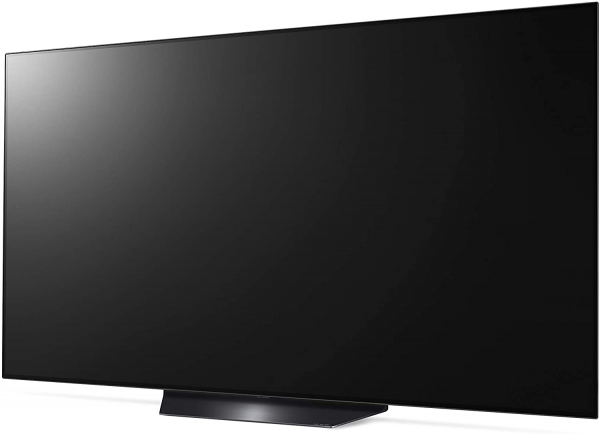
Video games
If so far Samsung LCD TVs dominated Oled TVs in terms of delay in display, it is now the other Korean manufacturer, LG, which takes the lead. The LG 65B9 thus displays a delay in display of only 12.7 ms. This model is therefore better than Oled LG and Panasonic TVs of 2018 which displayed a delay in the display of 21 ms. It is even better than Samsung Qled televisions whose input lag did not exceed 15 ms. The offset results in a delay of less than one image relative to the source. For comparison, PC screens go down to 10 ms, but on a TV this remains one of the best measured values. The LG TV also retains the advantage of Oled technology, with zero afterglow which results in very little blurring of moving objects. It is also possible to use the black image insertion system in game mode (Advanced options> TruMotion> OLED Motion).
We are now evaluating the color fidelity in Game mode, because the atmosphere designed by the creators of the game must be respected by the television, just like that of a film. By setting the white balance to Expert 2 temperature, it displays an average delta E of 2, below the threshold of 3. More interestingly, the TV supports the Auto Low Latency Mode (ALLM) of HDMI 2.1. This function automatically deactivates all image processing and therefore reduces the delay in display to a minimum when a compatible console is connected. The TV displays a thumbnail "Instant game response is started" which means that the ALLM is active and the delay in display is then 13 ms. You can then choose your preferred color mode (Standard, Vivid, Home Cinema or Cinema) and keep this delay on the display. To date, only Xbox One S and Xbox One X support ALLM.
If until now only Samsung TVs were compatible with FreeSync, this is no longer the case with HDMI 2.1 compatibility which brings to LG 65B9 VRR (Variable Refresh Rate), the equivalent of FreeSync, which works perfectly with Xbox One S / X between 40 and 60 fps (frames per second). LG TVs are also G-Sync compatible since the last firmware update. Like VRR, this system automatically sets the refresh rate of the TV screen to the number of frames per second sent by the console to avoid tearing of the image (tearing) and micro-slowdowns (stuttering). The TV supports a frequency range between 40 and 120 fps. If the 120 fps cannot be reached with a console, a PC will be able to use the television with a Full HD definition at 120 Hz and soon with an Ultra HD definition at 120 Hz ... the day when the graphics cards will ship an output HDMI 2.1, which is not the case with the latest high-end cards (GeForce RTX 2080 and AMD Radeon VII).
LG's Oled B9, C9 and E9 TVs, released in 2019, will receive an update this week bringing them compatibility with G-Sync ...
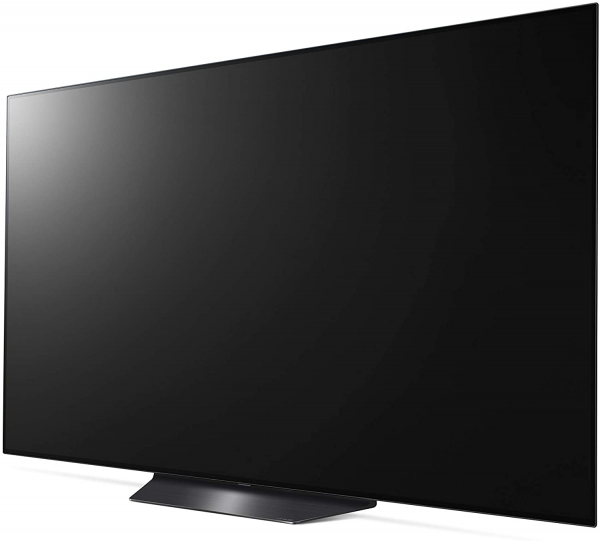
Clouding
As with all Oled TVs on the market, each pixel is managed individually and there is therefore no clouding. Banding effects (horizontal or vertical bands) are also absent on this model. The homogeneity of the brightness on the screen is excellent, since we have measured the average difference in uniformity of white across the entire screen from 65 inches to 8%. This excellent result is again explained by the use of Oled technology.
A little word all the same about the marking problems that some users face. Extensive tests have shown that the marking of modern Oled tiles is limited during everyday use. On the other hand, the chains of continuous information displaying bands with saturated colors (red, blue or green) can clearly pose problem, in particular when the brightness is pushed to the maximum. This risk exists and cannot be totally overlooked. Remember that you must switch off the television using the remote control and that it is not recommended to disconnect it completely from the power. The television performs maintenance operations on the screen when it is in standby in order to preserve uniformity and precisely to avoid marking problems.
Ergonomics
The LG 65B9 sports a very sober, unadorned design, which gives pride of place to the image. Note that the LG brand does not appear on the slab, but only on the foot with the mention "LG Oled". The foot is also particularly compact; it is much narrower than that of the LG C9 and even less wide than that of the LG B8 of last year.
When the TV is fixed to the wall, the LG logo no longer appears anywhere and the TV is thus purified to the maximum.
Oled technology makes it possible to reduce the screen edges which are very thin for a 65 inch television. This notably facilitates integration for those who have limited space.
If the anti-glare filter does not match that of the most high-end televisions from Samsung, the LG Oled 65B9 filters all the same a good part of the reflections and is one of the best pupils on the market of televisions. Note that all Oled TVs have the same anti-reflective filter since all the tiles come from the same manufacturer, LG Display.
The absence of a backlight system allows the TV to be very thin on the top. It is only a few millimeters thick. The lower part which contains the power supply and the electronics is a little wider (4.7 cm). As usual, the occupation on the TV stand is linked to that of the stand and LG is one of the good students here; the base of this Oled TV is very compact (only 24.6 cm deep). This TV is therefore perfectly comfortable on our reference TV stand measuring 160 x 40 cm.
The back of the Oled LG 65B9 TV is very simple. We find the power cable on the left and the connector on the right. The cable passage comes down to a simple plastic clip; it's always better than nothing.
If the connection is identical to that of the previous models, the HDMI ports are now compatible with HDMI 2.1, which is very significant. The TV offers four HDMI 2.1 inputs, three USB ports including a USB 3.0, an Ethernet port, an optical digital audio output, a headphone output, a PCMCIA (CI + Common Interface) port, a rake antenna connector and a satellite. It has a dual tuner DVB-T / T2, DVB-S / S2 and DVB-C (TNT, satellite and cable) and also has Wi-Fi 802.11a / b / g / n as well as Bluetooth 5.0 for connection with a wireless audio device (headphones or speaker).
Since 2019, LG televisions have been running webOS 4.5, which has a slightly lighter and less loaded design. The vertical strip disappears in favor of a more generous lower strip which groups together all the applications. It is possible to let the system intelligently manage the layout of applications, which are then classified according to their frequency of use (the most used on the left, those which are the least on the right). The set is still as pleasant to use and LG has worked particularly on the fluidity. The main applications are available (Netflix, YouTube, Amazon Prime, Google Play Films, BeIn, Spotify, OCS or Deezer), but a few are still missing (notably My Canal). They launch quickly and remain in memory for a rapid recovery. WebOS 4.5 always includes the Google Assistant voice assistant associated with the LG ThinQ AI layer. The latter can fetch content on many online platforms and adjust their responses to suit your tastes. The TV also has the Amazon Alexa assistant accessible via a long press on the Prime Video button. The Amazon Alexa ecosystem is very rich, it is possible to order all devices compatible with the Amazon assistant (bulbs, sockets, thermostats, camera, speaker, robot, etc.). Finally, like last year, voice controls offer the possibility of carrying out searches and controlling the television ("put such a channel", "record such a program", etc.), change the settings (switch to Game mode, in Cinema mode , etc.) and many more. Finally, the LG B9 is also compatible with AirPlay 2 and HomeKit from Apple.
In terms of responsiveness, WebOS always sets a benchmark, with the Tizen system from Samsung. The TV turns on in less than 4 seconds while consuming less than one watt in standby. The first start-up is extremely fast (around 5 s), especially compared to that of Android TVs which take around 45 s. Extinction is instantaneous.
Like most LG Oled TVs, the LG 65B9 Oled comes with the Magic Remote. We find the Netflix and Amazon Prime keys as well as the Quick Access button ("0" key) which allows you to configure shortcuts on the numeric keypad. Thanks to its very low center of gravity, it fits effortlessly in the palm of the hand. The gyroscope works wonderfully, as does the built-in microphone allowing voice searches. The remote control offers all the usual commands and two multimedia keys (Play and Pause). Unfortunately, the keys are still not backlit.
Audio
The LG 65B9 has two speakers and two subwoofers with a total power of 40 W. The audio system has not changed since the previous generation, but it ultimately does not need it since it delivers a sound of quality for a TV. The frequency response covers a range of 60 to 20,000 Hz, which corresponds to almost the entire spectrum. Those who want an even more immersive sound will opt for a sound bar or even a dedicated 5.1 kit.
Consumption
We measured the consumption of the LG OLED65B9 at only 96 W on our test chart. Relative consumption thus drops to 82 W / m², which is much lower than that of the LG 55B8 of the previous generation (100 W / m²). In comparison, the best LCDs on the market, like the Sony 65XG8505 (56 W / m²), the Samsung QE55Q6FN (61 W / m²) or even the TCL 55DP660 (66 W / m²) do much better, but LG is working in the right direction to reduce consumption of Oled TVs. Standby consumption is always less than 1 W.
Conclusion
Even if it is the cheapest of the Oled LG televisions of 2019/2020, the LG 65B9 is an excellent Ultra HD model, in line with the other Oled models offered by the manufacturer. The LG 65B9 is suitable for watching movies as well as playing video games or watching TV. The transition to the LG C9 will only be of interest to lovers of beautiful images who seek perfection. For everyone else, the LG 65B9 turns out to be excellent value for money in the Oled TV market.
Specifications

